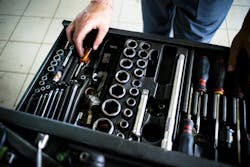The manner in which tools and equipment are organized and stored has an impact on both technician and shop productivity. Time is wasted if tools and equipment are not well organized, available, and readily accessible when required.
The time that technicians spend off a job when searching for a lost tool, or a tool required to complete a job, can add up quickly in reduced efficiency and increased cost.
Moreover, keeping tools organized helps a shop/technician keep track of tools. If a technician forgets to replace a tool after finishing a job, the empty space for the missing tool will be obvious.
Good organization and storage can also save space within a shop, plus help keep tools in proper working order for a longer time. When left scattered, tools and equipment are susceptible to getting dinged or damaged and could be the cause of an accident.
What’s more, lost tools and equipment are expensive to replace and could result in a job being delayed.
Best practices
Here are some tool storage recommendations:
- Make sure tools are stored so that they won't get damaged.
- Store tools to protect against possible accidental contact with any sharp or pointed edges.
- Organize tools so that those most frequently used are the easiest to access.
- Be certain that any tools placed on overhead storage shelves/racks won’t topple off.
- Be aware that some specialty tools may require unusual storage.
Checklist
Some general purchasing considerations:
- Needed storage capacity.
- Size, storage volume/spaciousness, style, configuration, etc.
- Number and size of compartments, trays, etc.
- Organizational options and accessories.
- How are tools and equipment safeguarded – built-in locks, latches designed for padlocks, electronic systems, or other secure locking mechanisms?
- Would complete systems for tool and asset monitoring and control be beneficial?
- Construction and material type.
- Strength and durability.
- Color, finish, fit, graphics, etc.
- How well will the storage solution fit in the work space or with existing storage solutions?
- Portable, wheeling, or stationary.
- Expandability/upgradeability.
- Quality.
- Warranty/guaranty.
- Product support.
- Brand reputation.
- Budget range/price.
About the Author

